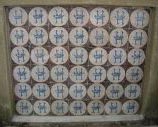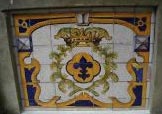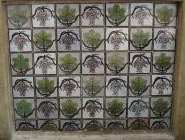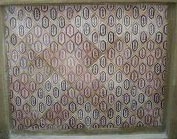Historical 2006
| Holland House Tiles | For centuries, until its destruction by bombing in 1940, Holland House was a focal point of political and social life in Kensington. With the loss of the house and a new focus on the creation of a public park around the ruins, Holland Park has now become one of London's most beautiful open spaces. The Royal Borough of Kensington and Chelsea is proud of the contribution it has made to enhancing and improving the park since we took over responsibility for it from the GLC at the end of the 1980's.
|
| Clare Spicer recalls | "The conservation of the tiles in Holland Park was perhaps the most challenging task I have ever undertaken. The damage to the panels and columns was very severe and in some cases almost complete. The full extent of the problems did not come to light until we started work. There are several different environments along the top walkway. The panels nearest Holland House are under the shade of a large chestnut tree and were therefore very damp. Some areas of tiles were unstable and they had to be removed in order to consolidate them. Once removed, we found moss and lichens growing actually in the tiles. Fortunately the weather was kind to us at the time and we were able to clean these areas and leave them to dry out before commencing with the restoration. The south-facing wall above the cafeteria is in full sun for most of the day: the loose areas here once removed revealed spiders nests among other things! However, the basic methods used to conserve the tiles were the same. After thorough cleaning of the surfaces we used a low viscosity epoxy to consolidate any loose areas. Then we filled the missing areas with a fast-setting polyester, which had to be sanded to a perfect finish before painting on the missing decoration with a modified epoxy glaze mixed with pigments to match the colours. Finally, we sealed the damaged tiles with the same glaze. As in all conservation, all materials used were reversible so that if a better solution is subsequently discovered, no permanent damage will have been done and the new treatment will be able to be used.  As with any work outside, the elements are always the main problem. We had gales, which blew the pigments away, torrential rain that made us very wet and miserable, and boiling sun, which made the glaze want to set before we could get it onto the tiles. The fact that we were a team made most of it enormously rewarding, even things that were very trying became more bearable together. So I must thank Kate and Luke for all their hard work. As with any work outside, the elements are always the main problem. We had gales, which blew the pigments away, torrential rain that made us very wet and miserable, and boiling sun, which made the glaze want to set before we could get it onto the tiles. The fact that we were a team made most of it enormously rewarding, even things that were very trying became more bearable together. So I must thank Kate and Luke for all their hard work.
Also the people in the Park were wonderful: the opera organisers and the security people were patient and helpful; Graham Vincent came up with new and innovative ideas to keep the rain off us; Stella Fear, the head gardener, was always ready to help and came up with some wonderful graffiti remover for the 'bird room' and of course Nicholas Hopkins was always so encouraging. It has been a wonderful experience in a beautiful Park with extraordinary people - and I just hope you can keep the hooligans away from the tiles!"
Clare Spicer
Ceramics Restoration |
| Conservation of the tiles | Completion of the ceramic tiles' conservation is certainly a reason to celebrate! It has been a long haul and there was a real risk that we would lose the tiles altogether. Year on year they suffered from rain getting into the supporting brickwork, turning to ice, expanding, and 'spalling' their surfaces, causing them to flake off. Conservation projects are inevitably subject to comparative priorities and the available funding, but the Friends ensured that while there were still tiles worth conserving they remained on the agenda. First, the cause of the damage had to be put right and temporary protection provided from the worst of the weather, but approval to conserve what was left of the fast-eroding tiles took a little longer!
Clare began work in May 2004, soon with everyone's full support and
The Friends immediately voted £40,000 towards the project, the largest
So the inaction of successive owners of the Park over many years has now been corrected successfully - in the nick of time! - and both the Friends of
Nicholas Hopkins
Chairman, Friends of Holland Park |
| Holland House ceramic tiles beautifully restored |
On Saturday 30 September at 11 am, the Friends celebrated with the Royal Borough the completion of a major joint project – the conservation of most of the twenty-three panels of ceramic tiles which adorn the walls under the arcade in front of the cafeteria and along the overhead walkway. Introducing Councillor Nicholas Paget-Brown, Cabinet Member for Environment, Arts and Leisure, Nicholas Hopkins reminded us that the tiles had almost been lost, they were in such a bad state and were deteriorating fast. So the Friends had stepped in and commissioned a study from Clare Spice, a ceramics conservator and had voted £ 40 000 towards the project to enable work to begin. With the active support of the former Councillor, Richard Walker-Arnott, the Royal Borough agreed to match this figure and Clare and her two helpers started work in May 2004. Declaring the restored tiles "open for viewing", Councillor Paget-Brown said that although Holland House itself had been destroyed by bombs in 1940, much still remained to be enjoyed in the park and he was delighted that the tiles had been given new life. Although the precise provenance and date of the tiles is not certain, records in the Local Studies Section of the Central Library describe them as "a colourfully decorated 130- year-old wall of Florentine tiles comprising twenty-three tiled panels built around 1850". The aim of the conservation work was to consolidate the damaged areas so as to prevent further deterioration and to create a good overall effect rather than a complete restoration of the damage. Where the tiles were unstable, they had first to be removed, sometimes revealing moss and lichens growing into them; some loose areas, once removed, even disclosed spiders' nests behind ! As in all conservation work, the materials used were reversible, so that if in the future a better solution were to be found, no permanent damage will have been done. The Friends are still hopeful of being able to open up a further section of the arcade beneath the overhead walkway and to conserve the tiles in this area as well. In the meantime the restored tiles near the cafeteria are there fo all to enjoy with their vibrant colours, beauty and craftsmanship.
Kathleen E Hall
[Winter 2006] |
| Extract from 'H is for Holland', written by Christopher Wood, former chairman of the Friends of Holland Park in 1999 |
The Overhead Walkway and Historic Tiles
The alcove by the cafeteria…is underneath the 'Overhead Walkway'. This
|
| A taste for oranges |
Orangeries, greenhouses, glasshouses, conservatories, call them what you will, although they each have a specific meaning, all have one purpose; that is to protect plants during cold weather and so improve on Mother Nature. As is so often the case, the Romans thought of them first. The Emperor Tiberius had a sort of greenhouse, called a specularium, which had a roof created from flakes of mica, so that he could have a year-round supply of his favourite food – cucumbers. Further developments of specularia included ducts carrying hot water or cool air from growing grapes, peaches and roses. The earliest greenhouses were practical garden buildings that could be completely covered by planks and sacking and which could be heated in the cold season by charcoal stoves. Such buildings existed in Great Britain and France as early as the second half of the sixteenth century. It would appear that in England the first orange trees were planted at Beddington near Croydon, and the diarist John Evelyn wrote in 1658 that they were protected by a "wooden tabernacle and stoves". But the orangery as we understand it was developed in the seventeeth century by northern European gardeners who had the difficult task of protecting citrus trees and other non-hardy plants in freezing weather. These were originally simple masonry structures which did no more than keep out the wind and were soon replaced by buildings specifically designed to maximise solar heating. The great period of the glasshouse or orangery was from the latter half of the seventeenth century into the early eighteenth century when they became a feature of royal palaces and noble houses throughout Europe. Peter the Great, ever the innovator, built greenhouses on the outskirts of St Petersburg shortly after the founding of the city at the beginning of the eighteenth century. At the same time, the French were building some quite large glass structures holding up to three hundred trees; at Versailles the orangery was more than 500 feet long and 42 feet wide. In England, William of Orange played an important part in popularising orangeries, not least because his dynastic name was "Orange". William was not only a competent soldier and politician, he was an accomplished gardener as well and grew many exotic fruits including pineapples which he served to his guests. – hence "pineries", yet another name for glasshouses. He also built a "gallery" at Hampton Court for growing oranges. This was the beginning of the British Empire and, as new territories were discovered, botanical specimens were sent back to England. Kew Gardens (officially the Royal Botanic Gardens at Kew) originally belonged to the royal family. Frederic, Prince of Wales, the son of George III, and his wife Princess Augusta had a great interest in exotic plants and their collection formed the basis of Kew's plant collection today. Sadly, none of the Georgian glasshouses at Kew have survived. In central London one of the most famous Regency conservatories was built at Carlton House, the Prince of Wales London residence, in 1787. It was demolished in 1826-7. Here in Kensington, the orangery at Kensington Palace built for Queen Anne in 1704-5 was an elaborate architectural structure designed in Sir Christopher Wren's studio, and is said to have been used by the Queen to entertain her friends to tea. In fact, orangeries and glasshouses were designed for the enjoyment of people as well as for the cultivation of plants, so the present use of this orangery as a restaurant is in keeping with tradition. The orangery in Holland Park was built by the fourth Lord Holland in 1849 as part of extensive improvements and is joined on to the building which is now the Belvedere restaurant – a rectangular structure surmounted by a turret in the style of an Italian loggia. However, an engraving dated 1852 entitled "Garden Fête given by Lord and Lady Holland" shows a structure quite unlike the present orangery being entirely of glass and without any sign of the brick arches on the west side facing the terrace; the present building would therefore appear to be of a later date. Princess Marie Liechtenstein, who wrote the first authoritative history of Holland House in 1875 says "From the so-called ballroom (ie the Belvedere which joins the conservatory we descend amidst a square of orange trees into what used to be called the Moats at the end of the kitchen garden..." Presumably, the trees were planted in pots so they could be brought in during the winter as was the usual practice. She also writes that the ballroom, which was used for Lady Holland's breakfasts "could be used for a lecture or revel on the shortest notice" ! She and her hustand would no doubt approve of the many ways both of these attractive buildings are used for the enjoyment of the public today.
Kathleen E Hall
|
| Memories from Holland Park |
In Holland Park, on the first day of October 2006, as I admired the beautifully restored tiles on the Upper Walk, I had a sudden sense that I had seen them before – but from a different level. Could this have been on a day in the mid-1930s (I was shorter then) when the grounds of Holland House were opened in aid of charity ? My mother took us there on at least one occasion, possibly two. My memory may be tricking me over the tiles, but not about the Oriental Garden with tropical plants and with a stream running through it. It impressed me very much; I wonder if the few large palm trees now remaining once formed part of this garden. (Yes, this was the precursor of our Japanese Garden - Rhoddy Wood.) In those days, the western boundary of the park marked the end of the gardens of the big houses on the east side of Addison Road. The only one surviving Opposite our house (No83) was Garden Lodge, the residence of the Russian Ambassador; further along came the Adeline Genee School of Dancing and then the home of Mrs. Van der Elst, much involved with prison reform, and only of interest to us because of the Black Maria that one stood outside her gates. My brother was allowed by the policeman in charge to climb inside. In 1938, land at the western end of Holland Park was compulsorily purchased by the Council, as reported in the "Times" : "Making a Country Road in the Heart of London"... "Kensington Borough Council, to relieve traffic in the Notting Hill Gate area, are having a 30-ft road between Addison Road (sic) and Holland Park Avenue to be the main artery from the north to the south sides... The new road cuts through Holland House, the Earl of Ilchester's residence. It has been a wild park for years... Today the woodland riot comes right to the edges of the new road. The scene is more like a cutting in the Surrey Weald... Rabbits have been seen... A few buildings will go up at each en of the road, but for the most part it will continue to be an avenue through quiet woods." Then, of course, came the war. The land to the west of the road lay derelict, and was used by the Training Cadre of "F" Zone Home Guard. My father was second-in-command of "F" Zone and trained his troops on that piece of land. In 1943, the third anniversary of the formation of the Home Quard, King George VI came to review them and, according to my father, one of the men firing the Royal Salute aimed rather badly and narrowly missed the monarq. My father was not above embellishing an incident, but the use of the land came as no surprise to him. In 1938 he had an air raid shelter dug in our back garden. When Neville Chamberlain returned from Munich with "Peace in our time", my father's friends laughed at him and asked him what he was going to do with the hole. He replied : "Dig it wider and deeper". It was, I believe, the first private air raid shelter in London. My parents slept in it all through the Blitz and again through the V-1 and V-2 rockets. One more memory of Holland Park comes in a letter from my younger brother. I think he must have been referring to 1949-1950. "Holland Park ! On the east flank there was a long walkway where I'd chain my bike to a lamp-post and "shimmy" over the wooden fence and spend the day exploring the closest thing I could find to a London jungle; and the bomb-damaged Holland House where I almost fell through the third floor and spent an hour thinking "good-bye to all this" before extricating my legs from the rotted planks. A half-dozen afternoons were spent alone in paradise until I was almost stalked by a tall figure in tweed coat and britches and a long rifle (Lord Holland or a gamekeeper?). After that, Holland Park lost its magic and I made only one more cautious invasion feeling like Robert Donat in the Highlands".
[Winter 2006] |
| Facelift for our historic tiles |
Saturday 30 September and Sunday 1 October Two years of skilful work by Clare Spicer to conserve the badly damaged, but beautiful ceramic tiles beside the cafeteria and along the upper walkway is now very successfully complete. To celebrate this great achievement, Councillor Nick Paget-Brown, The Royal Borough's Cabinet Member for Regeneration, Environmental Management and Leisure, will officially 'open' the renewed tiles at 11.00 am on Saturday 31 September. Everyone is welcome to attend and to inspect the tiles in their new glory. A leaflet about the tiles and their conservation will be available to visitors and Clare Spicer herself will be on hand to talk about the work and answer questions. Since most of the tiles are located along the upper walkway, which is not usually open to the public, arrangements have been made to allow access to view the tiles between 11.00 am and 4.00 pm on both the Saturday and Sunday. The walkway also affords quite different and exciting views over the Park and the Iris Garden, which most members will never before have had the chance to see.
If you would like to volun |

 The restoration of these tiles by Clare Spicer, from what was clearly a very poor state, marks a further milestone in this progress. They remind us of the importance of beauty, detail and craftsmanship in architecture and landscaping and of the sensitivity of the relationship between a building and its surroundings. I am extremely grateful to Clare and to the Friends of Holland Park for their initiative and skill in saving these beautiful decorations so that they can be enjoyed by future visitors to the park.
The restoration of these tiles by Clare Spicer, from what was clearly a very poor state, marks a further milestone in this progress. They remind us of the importance of beauty, detail and craftsmanship in architecture and landscaping and of the sensitivity of the relationship between a building and its surroundings. I am extremely grateful to Clare and to the Friends of Holland Park for their initiative and skill in saving these beautiful decorations so that they can be enjoyed by future visitors to the park.  That changed with the arrival of Clare Spicer, a restorer of ceramics, fresh
That changed with the arrival of Clare Spicer, a restorer of ceramics, fresh  We were also able to clean and conserve the panels on the ground floor and open up the right hand end of the arcade to conserve its attractive bird tiles. We are still hopeful of being able to regain and open up the arcade to the left of the archway; there would be further work to conserve the tiles in that area.
We were also able to clean and conserve the panels on the ground floor and open up the right hand end of the arcade to conserve its attractive bird tiles. We are still hopeful of being able to regain and open up the arcade to the left of the archway; there would be further work to conserve the tiles in that area.